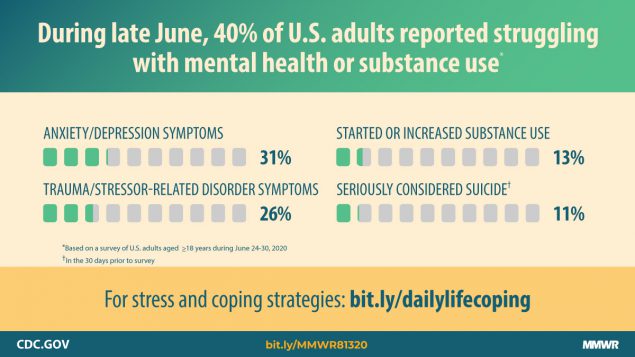Viscous Cycle: Pandemic Elevating Nation’s Blood Pressure, Which Increases COVID-19 Vulnerability
By Clive Riddle, September 3, 2020
The pandemic has increased our population’s stress levels, which has increased blood pressure levels, which creates a population more vulnerable to potential damaging effects of COVID-19. Livongo has released a paper: Tracking COVID-19’s Effect on the Nation’s High Blood Pressure, that examines their own national dataset in this regard.
Livongo refers to a August 14th CDC Morbidity and Mortality Weekly Report article: Mental Health, Substance Use, and Suicidal Ideation During the COVID-19 Pandemic, which cites that “symptoms of anxiety disorder and depressive disorder increased considerably in the United States during April–June of 2020, compared with the same period in 2019”, and presents findings from their survey taken June 24–30, 2020 that include “40.9% of respondents reported at least one adverse mental or behavioral health condition, including symptoms of anxiety disorder or depressive disorder (30.9%), symptoms of a trauma- and stressor-related disorder (TSRD) related to the pandemic (26.3%), and having started or increased substance use to cope with stress or emotions related to COVID-19 (13.3%).

Livongo reminds us that “while anxiety and stress do not directly cause long-term hypertension, episodes of psycho-social stress and anxiety are well known to cause dramatic spikes in blood pressure (BP).” They note there was a 136% increase in utilization of their myStrength behavioral health solution in the period from January to May.
Livongo’s dataset in this case is driven by Livongo for Hypertension Members that “regularly measure their BP with a monitor and cuff that connect wirelessly with Livongo’s smartphone app. Readings are automatically transmitted to our Applied Health Signals platform where participants can view results.”
Their analysis did indicate a pandemic BP spike, and they report “until late January of this year the percentage of our Members nationally with high BP in any given week was on average 62%. At the end of January, however, we saw a rise in high BP roughly corresponding with the announcement of the first confirmed case of COVID-19 in the US (Jan 21) and the first mass quarantine of residents in the Chinese city of Wuhan (Jan 23). From that point forward, the proportion of our Members with high BP has mostly remained at a heightened level above 62%. An initial analysis of data at the state level shows that in 30 states the percentage of Members with high BP has increased between January and August. According to the data, high BP reached another significant peak in early to mid April when 68% of our Members nationally registered high BP.”
The implications? Livongo reminds us that “while no more susceptible to COVID-19, this population is more at risk of serious illness, hospitalization, and death from the virus. As our BP data reveals, the stress and anxiety and social isolation we have all experienced has had an outsized and measurable impact on this at-risk population.”
Livongo wasn’t the first to note this pandemic spike. Back in May, St. Luke’s Kansas City released an article in which their medical director discussed the trend: Doctors seeing more patients with high blood pressure amid coronavirus pandemic.
The American Heart Association has recently updated a guidance page: Keeping a lid on blood pressure during the coronavirus crisis, noting the need to manage stress, and cautioning that “high blood pressure might raise your risk of experiencing severe complications from the coronavirus. Nearly half of U.S. adults have high blood pressure, or hypertension, which is defined as consistent readings of 130/80 or above.”
 Post a Comment By
Post a Comment By  Riddle, Clive |
Riddle, Clive |  Thursday, September 3, 2020 at 01:21PM tagged
Thursday, September 3, 2020 at 01:21PM tagged  Surveys & Reports|
Surveys & Reports|  Trends & Strategies
Trends & Strategies 

Reader Comments